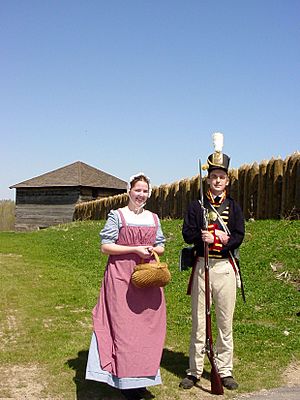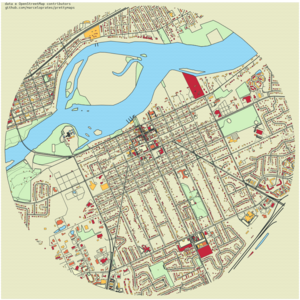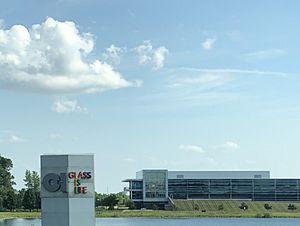Perrysburg, Ohio facts for kids
Quick facts for kids
Perrysburg, Ohio
|
|
|---|---|
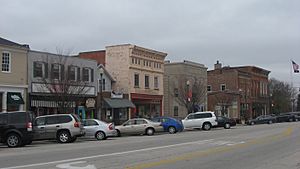
Downtown Perrysburg
|
|
| Motto(s):
"Embracing Our Past. Poised For The Future."
|
|

Location of Perrysburg in Wood County
|
|
| Country | United States |
| State | Ohio |
| County | Wood |
| Area | |
| • Total | 11.93 sq mi (30.91 km2) |
| • Land | 11.89 sq mi (30.80 km2) |
| • Water | 0.04 sq mi (0.11 km2) |
| Elevation | 637 ft (194 m) |
| Population
(2020)
|
|
| • Total | 25,041 |
| • Density | 1,818.53/sq mi (702.15/km2) |
| Time zone | UTC-5 (Eastern (EST)) |
| • Summer (DST) | UTC-4 (EDT) |
| ZIP codes |
43551–43552
|
| Area code(s) | 419 |
| FIPS code | 39-62148 |
| GNIS feature ID | 1087193 |
Perrysburg is a city in Wood County, Ohio, United States. It sits on the south side of the Maumee River. In 2020, about 25,041 people lived there. Perrysburg is part of the Toledo metropolitan area and is about 12 miles southwest of Toledo. It used to be the county seat from 1822 to 1868.
A team of surveyors mapped out Perrysburg in the summer of 1816. There's a story that Charles Pierre L'Enfant, who designed Washington, DC, also designed Perrysburg. However, this story is not supported by facts.
Contents
History of Perrysburg
Early Beginnings
Perrysburg is located in an area once called the Twelve Mile Square Reservation. This land was given to the United States in 1795 by the Odawa people. The Odawa had lived here since the early 1700s, after settling near the French trading post at Fort Detroit. They controlled much of the land along the Maumee River in what is now northwestern Ohio.
In 1810, some of the first European-American settlers arrived. These included Major Amos Spafford and his family. Spafford was a surveyor from Connecticut. He helped create the first map of Cleveland and named the city. He later became a US Customs Collector and postmaster for the port on the Maumee River. By 1812, 67 families lived in the area. However, most of them left when the War of 1812 began.
After the war, Spafford returned. He settled on land given to him by President James Monroe. Other war veterans also received land grants and settled nearby.
The War of 1812 and Fort Meigs
As the War of 1812 moved into Northwest Ohio, General William Henry Harrison ordered a fort to be built. Construction started in February 1813. Harrison later became the ninth president of the United States. The fort was named Fort Meigs after Ohio's fourth governor, Return Jonathan Meigs.
Fort Meigs was built on a high bank above the Maumee River. It was designed by army engineer Captain Eleazer D. Wood. Wood County would later be named after him. Two important battles against the British took place at Fort Meigs during the War of 1812.
Early settlers had left the area during the war. They returned and first settled in a lower area called Orleans. But after floods, they moved to higher ground.
Alexander Bourne led the team that surveyed and mapped Perrysburg. This survey happened in June and July of 1816.
How Perrysburg Grew
Perrysburg quickly became a hub for shipbuilding and trade on Lake Erie. The city was named after Commodore Oliver Hazard Perry. He was a naval commander during the War of 1812 and a hero of the Battle of Lake Erie. Perrysburg was the county seat from 1822 to 1868.
By 1833, Perrysburg had a courthouse, a jail, a school, stores, taverns, doctors, and lawyers. About 250 people lived in 60 houses.
Henry Bibb stayed in Perrysburg during the winter of 1837–38. He had just escaped from slavery. He was helped by the free Black community in Perrysburg, which included many fugitive slaves. Bibb found work and saved money to help his wife and children escape slavery. His knowledge of Perrysburg later helped him in another escape attempt. He could answer questions about the town, making people believe he was a free resident.
In 1854, a serious illness called cholera spread through the town. It was carried by people traveling along the waterways because there was no good way to clean waste. Perrysburg closed down for two months that summer to try and stop the illness. More than 100 people died. Other towns along the Maumee River also suffered many losses.
The railroad arrived in 1859. This was the Dayton and Michigan Railroad. Today, this line is part of CSX, but no passenger trains use it.
Perrysburg Today
On October 12, 1984, President Ronald Reagan visited Perrysburg. He stopped during a train tour in the historic Ferdinand Magellan railroad car. Over 20,000 people came to see him.
Geography
The United States Census Bureau says that Perrysburg covers about 11.51 square miles (30.91 square kilometers) of land.
Population Information
| Historical population | |||
|---|---|---|---|
| Census | Pop. | %± | |
| 1830 | 182 | — | |
| 1840 | 1,041 | 472.0% | |
| 1850 | 1,199 | 15.2% | |
| 1860 | 1,494 | 24.6% | |
| 1870 | 1,835 | 22.8% | |
| 1880 | 1,909 | 4.0% | |
| 1890 | 1,747 | −8.5% | |
| 1900 | 1,766 | 1.1% | |
| 1910 | 1,913 | 8.3% | |
| 1920 | 2,429 | 27.0% | |
| 1930 | 3,182 | 31.0% | |
| 1940 | 3,457 | 8.6% | |
| 1950 | 4,006 | 15.9% | |
| 1960 | 5,519 | 37.8% | |
| 1970 | 7,693 | 39.4% | |
| 1980 | 10,196 | 32.5% | |
| 1990 | 12,551 | 23.1% | |
| 2000 | 16,945 | 35.0% | |
| 2010 | 20,623 | 21.7% | |
| 2020 | 25,041 | 21.4% | |
| Sources: | |||
2010 Census Details
In 2010, there were 20,623 people living in Perrysburg. There were 8,246 households and 5,504 families. The city had about 1,792 people per square mile (702 people per square kilometer).
Most of the people in Perrysburg were White (92.9%). There were also African American (1.4%), Native American (0.1%), and Asian (3.1%) residents. About 3.2% of the population was Hispanic or Latino.
About 34.7% of households had children under 18 living with them. Most households (56.5%) were married couples. The average household had 2.48 people, and the average family had 3.10 people.
The average age in the city was 38.4 years. About 26.5% of residents were under 18. About 12.3% were 65 years or older.
Education in Perrysburg
Perrysburg has several schools. These include The Islamic School of Greater Toledo, Saint Rose School, and the Perrysburg Schools. The Perrysburg Schools system has a preschool, four elementary schools, one intermediate school, one junior high school, and Perrysburg High School.
In 2016, more than half (51%) of Perrysburg residents over 25 had a college degree or higher. This is much higher than the average for Ohio and the U.S.
Way Public Library
The Way Public Library serves the Perrysburg area. In 2016, the library loaned out over 639,000 items. It also offered 726 programs to its 34,336 registered users. The library had over 93,000 print books and 182 magazine subscriptions.
Famous People from Perrysburg
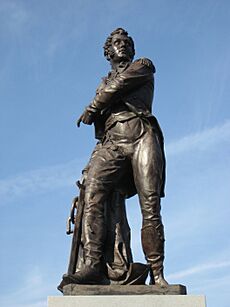
- Burke Badenhop, a professional baseball pitcher
- Clara Blinn, an early pioneer
- Douglas Brinkley, a historian who lived in Perrysburg
- Bil Dwyer, a cartoonist
- T. J. Fatinikun, a professional football player
- Jerry Glanville, an NFL and college football coach
- Jim Harbaugh, a professional football player and coach
- John Harbaugh, an NFL head coach
- Sam Jaeger, an actor and screenwriter
- Ralph Wesley Judd, a professional baseball player
- Charles F. Kurfess, a former Ohio Speaker of the House
- Lance K. Landrum, a U.S. Air Force lieutenant general
- Jim Leyland, a professional baseball player and manager
- Chessy Rayner, a socialite and interior designer
- Anna Tunnicliffe, an Olympic gold medalist in sailing
Companies in Perrysburg
- Burkett Restaurant Equipment, a company that sells food service equipment
- Owens-Illinois Inc., a global company that makes glass containers
- Universal Tube & Rollform Equipment, a dealer in metalworking machines
- Fox Software, a company that created FoxPro (now owned by Microsoft)
More Information
- Franks, Gary L. The Founding and Survey of Perrysburg, Ohio; Collierville TN: InstantPublisher.com, 2018
See also
 In Spanish: Perrysburg (Ohio) para niños
In Spanish: Perrysburg (Ohio) para niños




